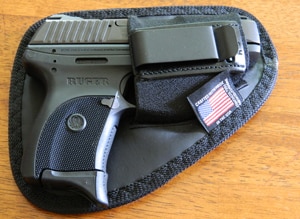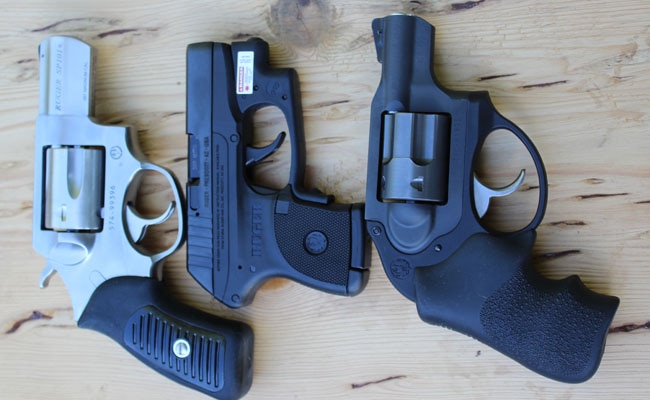We get a fare share of messages and questions sent to us and we try to answer what we can. But every once in a while a reader asks us a question that we’d just like to share with everyone. And the answers that some of our writers had. The reader asked:
I’d like your opinion: I’m looking for a personal protection pistol that I can comfortably use and is reliable. I’m and average size female in my 50’s, don’t have a strong pincher grip, so need one which doesn’t have a hard slide. Looked at a Walther PK380 and a Sig P250 SC today; liked them both. Then, at another gun shop was told that I should not use anything smaller than a 9 mm for CC protection. I’m getting frustrated, and could use some suggestions. Thanks in advance for your time.
A response from Jennifer Cruz, Guns.com writer:
It’s nice that our readers feel they can come to us with questions. Not everyone is fortunate enough to have a spouse, friend or family member with not only enough knowledge to help with such choices, but enough concern for their safety to take the time to help make that choice.
There are other writers here at Guns.com that have much more knowledge of specific models than myself. However, I can certainly share my own experience, especially as it relates to being a petite, not so strong female choosing a handgun in a predominately male oriented industry.
My first handgun was a .380 that my husband bought for me secondhand. It was cheap, not extremely accurate or reliable even, but it was good in the sense that it helped me to become more comfortable with handguns in the privacy of my own home. We’ve since sold that gun and moved on to better quality firearms.
My second handgun, which is the one I use for concealed carry, is a Ruger LC9. It is, by far, my favorite gun. It is the one that I am most comfortable and confident with. I use it for both self defense and home defense.
I spent several hours at the gun counter before I made my final decision. When it came down to it, it was a toss up between the Kel-Tec PF9 and the Ruger LC9, but not before I had literally put my hands on nearly every single gun on that wall.
They always look different on the wall than they actually feel in your hands. Some looked bigger than they actually were and others looked smaller than what they really were. The single most important factor in deciding on a handgun is comfort. You can not let someone tell you what gun you need to buy or which one is best for you. And the best way to find the most comfortable one is by handling a lot of various models.
I initially chose a 9mm at the recommendation of my husband. Of course, the decision was ultimately mine, but he felt more comfortable knowing that I was packing a bigger punch. At the time I just went with that, but after writing defensive gun use stories for some time now I kind of get it. The one incident that sticks in my mind above all others is about a mother in Georgia who shot an intruder five times with a .38 and even after five bullets in him, he still didn’t drop.
That, in my mind, is a scary thing. I carry the biggest caliber that I am comfortable with at the moment because in the event that I need my gun for self defense I don’t want to take a chance on whether or not the bullet size will suffice to drop the person trying to harm me or my children. That said, sometimes you have to work your way up to feeling more confident with a larger calibers, and there’s nothing at all wrong with that.
Even beyond caliber sizes though, the quality or brands differs dramatically. I always thought that a .40 caliber was too big for me, but I later learned that it wasn’t the size of the gun, it was the quality of it.
I had tried several times to become comfortable with a Taurus PT 640, but try as I could, I just was not able to pull the slide on it. I tried and tried, but I just couldn’t do it. My husband however, racks the slide on it like nothing. I dismissed the idea of a .40 and continued on with the comfort of my LC9.
Then I had chance to try out a Glock 27, which is also a .40 caliber, and the difference was night and day. There was no comparison. I could rack the slide on the Glock just as easily as my Ruger, proving that it was the brand, not the size. Which goes back to my previous advice: Handle as many guns as possible, hold them, feel them, pull the slide. If it’s not comfortable to you at the gun counter, it won’t be comfortable at home, even after being broke in.
There are other features to think about as well, which will vary depending on your personal situation. I have three small children at home and the fact that the Kel-Tec did not have an external safety was a huge factor in me deciding not to buy it. Also, as much as I love my Ruger, I’m now considering purchasing a revolver for concealed carry. The reason being is that two of my three children are still in car seats. In the event that I needed to fire my gun in my car, I don’t want to have to worry about piping hot brass landing on my children.
From David Higginbotham, Guns.com writer:
I faced a similar dilemma recently when my mother decided she wanted to carry a gun. She is 70 and has even more issues with operating slides. She came up for a weekend and we tried out several guns, even some of the easier .380s, and she couldn’t handle the basic loading and unloading of the pistols. That is something that is often overlooked, I think, but it is an action you may perform daily.
She decided on a revolver, and we landed on the Ruger SP101 in .357. That solved the slide problem, the caliber question, and the reliability issue. I know you specifically asked about a pistol, but I’m going to point at the revolver. The .357 spanks every common automatic pistol caliber (except the 10mm).
And since .357s also shoot .38, you can train with light-weight, easy to manage ammunition and carry the heavy hitters. There is no automatic pistol that is as easy to use or as reliable as a revolver. And the size is comparable. But most concealed carry revolvers will only hold five rounds.
If you want a pistol, though, there are options. I’m going to come out against the bigger-is-better argument. The terminal ballistic performance of larger calibers is more impressive. More effective. Yet it isn’t everything. The .380 is more easily concealed, and easier to shoot. And easier to shoot more than once.
As the recoil is lighter, they require less spring tension for their slides. Once you get to the 9mm, the .40 or the .45 ACP, spring tensions will be heavier. The spring in the slide has to be stiff. No engineer has found a way around that yet.
If you want a 9mm, I’d look at the Ruger LC9. It is inexpensive, light, and easy to use. The Beretta Nano would be my choice for a 9mm.
If you want a heavyweight round, the Glock 30S and Springfield XDS are leading the way. The Glock is a bit larger than the Springfield, but holds more rounds.
In the end, the most important thing is that you carry. Often the presentation of a gun is enough to end a conflict. Practice and proficiency will make even modest calibers very effective. But larger calibers have their appeal.
And, to go back on my own advice, you will be loading and unloading your gun in the privacy of your own home. You can get creative, like pressing the slide on the edge of a table, and make it work. Or you can try some of the adaptive devices, like the Slide Pull Charging Handle, from Brasscatcher.com. There are ways to make it work.
The post Ask Guns.com! What caliber for concealed carry (for the ladies)? appeared first on Guns.com.







